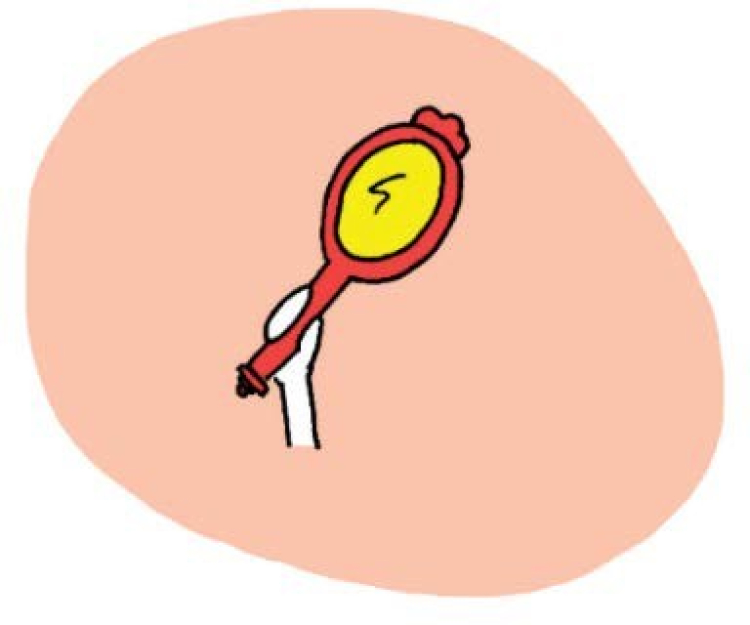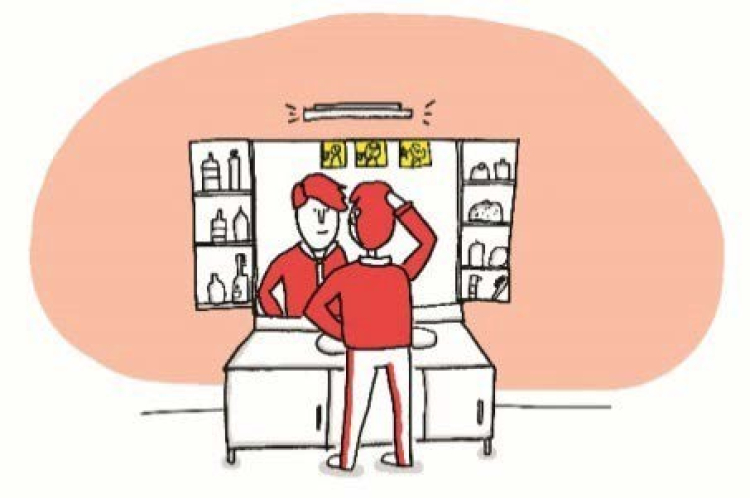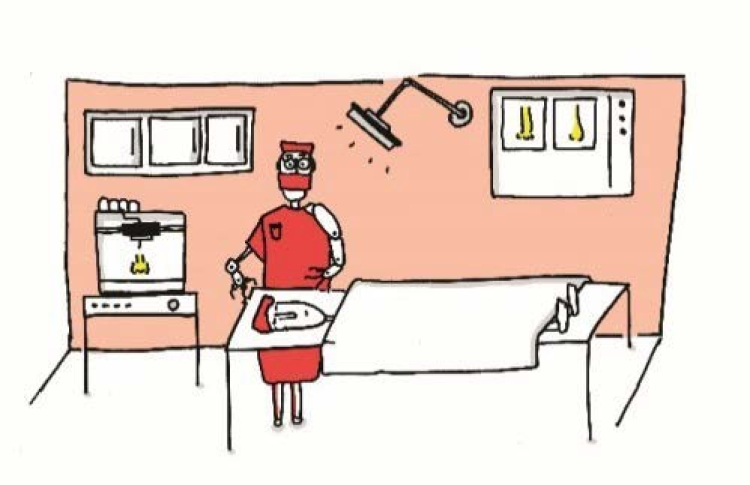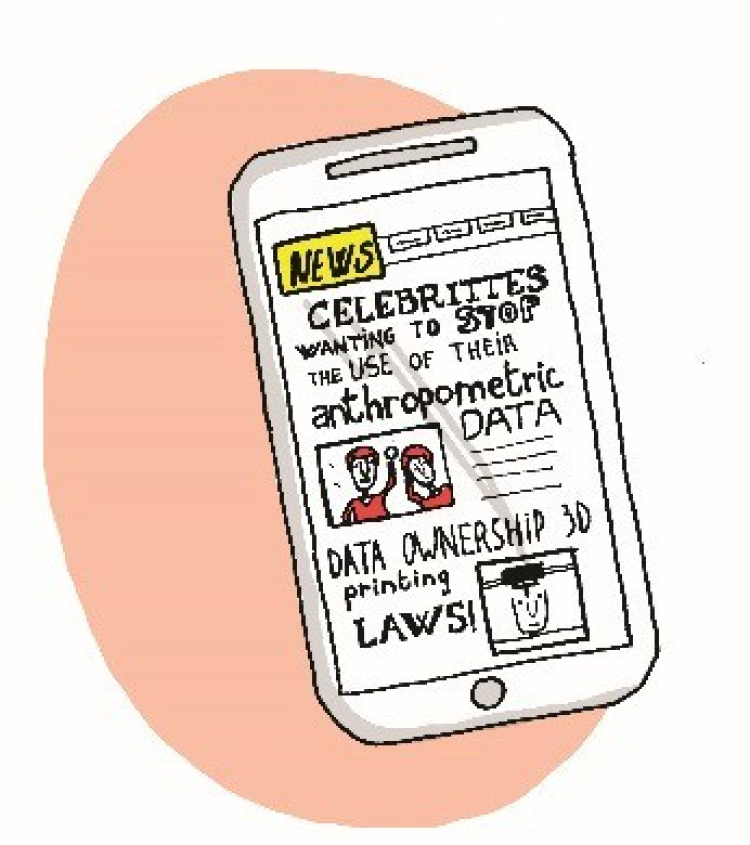Visions of the future: a famous nose?
The future of 3D bioprinting is still unclear, but we cán discuss the possible ramifications of this technology.

Onderstaand fictief scenario is geen voorspelling voor de toekomst, maar een manier om de discussie te voeren over mogelijke kansen en risico's van de ontwikkeling van 3D-bioprinten.
Dit scenario ontwikkelde het Rathenau Instituut voor het Engelstalige rapport 'Additive biomanufacturing' en is niet vertaald.
What happens when money buys faces?
In this scenario, François replaces his nose by a 3D printed version of a celebrity’s nose. After a while, and after the celebrity finds out, he doesn’t feel so confident anymore.
François was a rising star, the head of a small, specialised unit at one of the most prestigious FinTech companies at La Défense in Paris. He had a fifth-floor apartment with view of the Eiffel tower, he was good- looking, and he dated a lot, but nothing serious.
François inspected himself in his bathroom mirror and felt truly smitten. He looked stunning in his new haute couture suit by his favourite designer. He’d been told that he resembled the famous male model, Giovanni Borsa, who represented the designer’s label. François liked this label a lot, especially the shoes with custom 3D printed soles.
His collection of hair and skin products was impressive. François had always treated his skin with the greatest of care. Skin cancer had reached epidemic proportions in recent years. It had become very easy to diagnose. There had been many public health campaigns during the years, but many people neglected the warning signs until it was too late. Really stupid, he thought, smartphones warned you if they detected signs of skin cancer on your selfies. What more did these people want? He found it ironic that despite good diagnostics, there had not been much progress in treatment.
A cure for cancer had always been the holy grail. He wondered why technology had delivered custom-printed lightweight airplane parts and more sustainable biofuels, but not very much in the way of better healthcare. It turned out to be much more difficult than researchers had anticipated. And politicians were always talking about the ethics and the need to proceed with caution. Some people felt that things like bioengineering and tissue printing were unnatural and should be banned. Crowds had taken to the streets of Paris in protest. As a result, high-end research that seemed promising in the past had been discontinued. Many people were also struggling with the costs of privatised healthcare.

He put on some sunscreen and inspected his face. From the side, he really did resemble Giovanni Borsa, like two peas in a pod, but from the front he clearly had a different jawline, cheekbones and nose. That bothered him. On his online dating profile, he only used pictures showing his face from a perfect angle. He also used a fake name: Giovanni. It was his little trick to make women think he was the famous model. And often, it worked. Most of the time he told them straight away that he wasn’t that Giovanni.
Still, it gave him a little head start and worked as a nice conversation opener. His phone beeped. Another match! Nathalie, female model. Gorgeous! She messaged him: “Giovanni, is that really you?” He smiled. Maybe he should make the resemblance perfect.
“Choose your favourite celebrity’s nose”
Later that morning, at the office, he could not resist the thought and looked up the beauty clinic where he had his hair replacement therapy and eyelid correction four years ago. They would surely have new techniques by now. The clinic’s slick website said: “Have your dream face, choose your favourite celebrity’s nose.” The website showed how people could have the same nose as their favourite singer or actress. 3D print technology could create a bone implant with perfect precision – much better than the old-fashioned rhinoplasty that François had undergone years ago. The clinic claimed to have the best data, with the most precise data sets on celebrities all around the world. They not only printed nose implants but also cheekbones and jawlines. François got very excited. Would they have data on Giovanni Borsa too?
Although some of the pictures of the nose replacement procedure looked scary, François knew that he had to go through with it. It took only three clicks on the website to make an appointment. Within a week, François found himself at the fancy clinic. An attractive doctor explained the process. There was nothing to be scared of. Basically, it was like any other plastic surgery. The only new bit was that they would print the cartilage for his nose and jawbone during the operation, in a shape that would make the perfect nose for him – the nose of Giovanni Borsa. And they would use a scanner to determine the exact location of his facial nerves and veins so that the nose fit perfectly. “You must understand that this is not for everyone,” she continued. “Here is an overview of the costs. Prices depend on the number of implants needed for the best result. And we need you to take the psychological test.” François wasn’t bothered about the test, but the price tag made him swallow and hesitate. “Alright, I’ll do it. I have to do it. I need this,” he convinced himself. After all, he had done well on the stock market and expected a nice bonus. A month later, he would undergo the procedure. He would spend a week recovering in the clinic. “We’ll treat you well,” the doctor promised him with a smile.
“That much money for a nose?”
And they did! The week in the clinic was almost like being in a holiday resort, although he felt pretty awful the first few days with his face all swollen. On the first day, they had taken very precise measurements of his facial bone structures and matched these with the data on Giovanni Borsa’s facial features. To reduce the swelling and improve the result, they had even given him a 3D printed facial mask to wear most days. He hadn’t felt so undatable in a long time. With a big bottle of painkillers tucked into his bag, François was ready to go home. He had to take off for another week to recover. His face was still a little bit swollen, but the doctor told him the swelling would slowly subside and his bruises fade.
Two months later, François was on another first date. Eva and he had really hit it off and they lingered in the café. He told her more than he’d intended about his recent upgrade. “What!” Eva exclaimed. “You totally tricked me!” She was obviously upset. “I didn’t know they could do that.” She gave him a strange look. “Why would anyone want to do this? Why would you want to put so much money into this?”
An hour before, she had told him about her mum and dad. They were both very ill. Her dad had skin cancer and her mum had colon cancer. For years she had put all her hope into the new treatments that the doctors were promising. They always said that they would soon be able to grow new intestines in the lab and cure her mother. But it never happened. The research on 3D printed body parts had stalled, they told her. And now François was saying that they could actually print noses and faces, just for fun!

And of course, her dad should have checked his moles much sooner. Her app had even warned her about his skin when she posted a family picture. And there had been all those public health campaigns. Now it was too late to treat him because he didn’t have the money. There were therapies abroad but they were far too expensive. The ageing population meant that privatised healthcare costs were sky- high and they could not afford the travel and clinics on their own. Besides, dad had a high-risk profile and ignored the warning signs, so the insurance would cover only a fraction of his medical expenses. And now she was sitting here with François, who bought the most advanced treatment for a bizarre reason. “Is this what you spent your money on? While my parents are told that they’re incurable just because they don’t have the money? It’s so unfair!”

“Our faces are our data”
The next morning, François woke up a little sad that Eva had left soon after he had told her about his facial surgery. But he cheered up when he saw his beautiful face in the mirror.
As he ate his breakfast, he watched a news report about Giovanni Borsa. Borsa was apparently suing various clinics for using his facial data. And he was not the only one doing so. Other celebrities were also trying to stop clinics from using databases containing their body data. They claimed that it was their data and that they should own it. The clinics, however, claimed the intellectual property rights because they had generated the data from photographs and moving images in the public domain. Plastic surgeons said they were confused that celebrities were suddenly suing them over this. If you’re a celebrity, then people want to look like you. That had always been the case and they simply helped these people make their dream come true. Experts in the news studio, however, said that the celebrities might have a good case, and people mimicking their favourite celebrity could also be affected. Was it punishable? Should it be reversed? Should François pay Boras to look like him? The news commentators talked about sensors that would measure similarities between facial features to determine the need for legal action. All of a sudden, François no longer felt so confident about his good looks.

This scenario explores the possible consequences of:
• slow progress of research and development in life sciences in the EU;
• lack of supportive regulation for bioprinting and AM;
• individualisation;
• privatisation of healthcare (high insurance fees and limited reimbursement);
• crucial role of healthcare insurance providers;
• governments are reactive in terms of regulation and oversight;
• beauty: urge for the perfect body;
• social segregation;
• 3D printing for production is standard outside the medical field.
Illustraties met dank aan le Laboratoire d'Usages Collaboratifs.